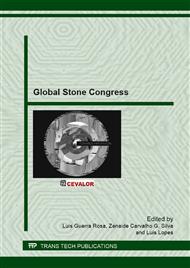p.183
p.189
p.197
p.205
p.212
p.220
p.231
p.239
p.247
The Example of the Quartzite from the "Upper Quartzite Formation" from Trás-os-Montes and Alto Douro (Northern Portugal); Its Characterization to Use as Natural Stone
Abstract:
Metaquartzite from Serra da Garraia and Zebras were studied. These rocks belong to the "Upper Quartzite Formation" of the “Parautochthonous Complex”. They are light grey and present, sometimes, a brownish patina. The quarries range from 2 to 10m high and 25 to 40m long. This study consists on the petrographic, chemical and physical-mechanical characterization of these rocks, aiming the determination of their potential as natural stone. The petrographic studies revealed that the rocks are formed by quartz and white mica and accessory opaque minerals (titanomagnetite, magnetite, and hematite) and zircon. The petrographic studies and SiO2 and Al2O3 values revealed a different evolution for Garraia and Zebras in terms of textural maturity and mineralogical differentiation. The studies allowed the distinction between quartzites and quartz phyllites. The physical-mechanical analyses attest that all the studied rocks can be used as natural stones.
Info:
Periodical:
Pages:
212-219
Citation:
Online since:
April 2013
Keywords:
Price:
Сopyright:
© 2013 Trans Tech Publications Ltd. All Rights Reserved
Share:
Citation:


